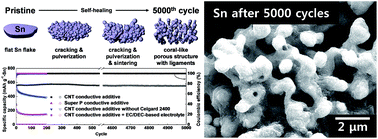A self-healing Sn anode with an ultra-long cycle life for sodium-ion batteries†
Abstract
For a next-generation sodium battery to replace lithium ion batteries, it is essential to develop an anode with a long cycle life and high rate. Sn is considered to be an ideal candidate for the anode of sodium ion batteries. Here, we report a Sn anode that exhibits ultra-long-term cycle stability with a high capacity of 554 mA h g−1 at 10C-rate for 5000 cycles. The optimized cell configuration consists of 1,2-dimethoxyethane as the electrolyte, a double separator including a nanoporous membrane, and a Sn anode with MWCNT as a conductive additive. Its capacity retention reaches up to 99.8% and its coulombic efficiency is near 100% for 5000 cycles. Surprisingly, we have discovered that the Sn powder exhibits a self-healing phenomenon during cycling. Sn is initially pulverized into a nanometer-sized powder, and then forms a three-dimensional porous coral-like structure in which ligament-shaped micrometer-sized Sn particles are connected with a low coordination number by room temperature sintering. The coral-like structure is mechanically stable towards volume change and electrically connected. The self-healing structure and mechanism provide a direction for the design of other electrodes with alloying mechanisms.



 Please wait while we load your content...
Please wait while we load your content...